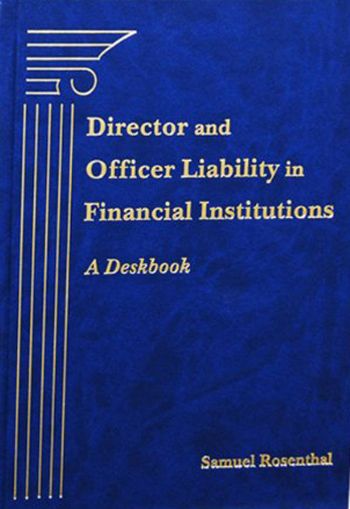Defending your boardroom life
Book Review: Everything Ds & Os need to know about defense
- |
- Written by Nahum Goldmann, president, ARRAY Development, Ottawa, Canada.
- |
- Comments: DISQUS_COMMENTS
 Director and Officer Liability in Financial Institutions: A Deskbook. By Samuel Rosenthal. Bloomberg BNA. 1,084 pp.
Director and Officer Liability in Financial Institutions: A Deskbook. By Samuel Rosenthal. Bloomberg BNA. 1,084 pp.
“Directors or executives can be sued, fined, barred from the industry or even jailed for conduct that years ago would have merited little or no attention from regulators and prosecutors”—Samuel Rosenthal, in his preface
This in-depth book of historical, statutory, and practical analysis and reasoning is based on author Samuel Rosenthal‘s ample experience as a practicing lawyer, representing directors and officers of financial firms. Previously, he was an Assistant U.S. Attorney and also served as Chief, Criminal Appellate Section, U.S. Department of Justice.
The book includes thousands of citations and numerous tables, legal forms, templates of resolutions, letters and agreements, as well as a comprehensive table of state statutes, lists of recent FDIC D&O lawsuits, selected jury instructions, and case descriptions. Clearly written and well defined, it is a "must have" analytical and practical reference for lawyers and executives alike.
The book explores recent developments in liability that have been deeply affected by the new compliance and enforcement frameworks, by the financial crisis litigation and their impact on the financial industry directors and officers. Thus, a chapter on the statutory landscape lists no less than twelve (!) federal laws as sources of D&O liability. These range from the Federal Deposit Insurance Act to Sarbanes-Oxley to Dodd-Frank. The list goes on and on.
Legal cycle follows economic cycle
Rosenthal’s coverage of crises in Chapter 1 is not just for its historic value or to help readers learn from the past (if only!). The author illustrates that each banking crisis has been inevitably followed by a wave of lawsuits and criminal prosecutions of bankers and other financial executives and introduction of new, more restrictive expensive regulatory frameworks. As stated in the Preface:
“By virtue of the governmental pressure brought to bear on directors and officers, they now must account not only for the viability of their entities, but also for any transactions in which third parties are victimizing those same entities by engaging in illegal activities, such as money laundering or theft of customer financial data. Accordingly, while directors and officers had to be concerned twenty years ago about being sued or prosecuted for engaging in fraud or other self-dealing at the expense of the institution they served, they now have to be concerned about hiring sophisticated staff to handle issues that did not even exist in the eighties, such as those involving anti-money laundering and suspicious activity reports. These two areas alone obligate directors and officers to become familiar with complicated laws and to find the technology and skill sets required to identify and report suspicious transactions.”
Rosenthal also noted that outside professionals retained by a bank, such as lawyers, accountants, appraisers, also risk being sued. Plaintiffs might claim damages for faulty loans, lending practices, consumer fraud, privacy protections, or just poorly managed operations affecting stockholder value. Moreover, many federal and states authorities plan to litigate both civil and criminal cases in parallel.
An aid to self-protection
This book could help directors, executives, and their lawyers in mastering defense against civil, criminal, and administrative liability originated by governments or private parties. In addition to court rulings, it also discusses the likelihood of liability prosecution brought by the regulators and enforcing agencies against directors and officers in such critical areas of liability as: failing banks, privacy policies, AML, mortgage-backed security litigation, risk associated with lending, money transmitting, consumer protection, and even risks of cooperating or non-cooperating with the authorities.
Even more important, Rosenthal outlines proven strategies for proactive defenses and includes useful document templates to prevent liability lawsuits.
Nineteen comprehensive Chapters are grouped in three parts, with every chapter further split into subsections far too numerous to mention. “Part I: Sources of Liability” covers the statutory landscape; duties of directors, officers, and other insiders; civil liability of insiders; civil liability of directors and officers under federal statutes; civil liability of consultants to financial institutions; criminal liability; consumer protection and privacy; and administrative actions.
“Part II: Governmental Enforcement” includes chapters on governmental agencies involved in enforcement; recent civil actions and policies by the federal agencies; recent criminal actions against directors, officers, and consultants to financial institutions; and the government investigation.
“Part III: Defense Techniques and Tactics” treats the pre-litigation defense investigation; the civil case; criminal proceedings; special problems of parallel proceedings; joint-defense agreements and privileges; and paying for the cost of defense..
That last chapter provides practical guidance on how bank directors and employee can manage the cost of defense, which might sometimes happen years after the director or officer has already left the bank.
A good guide to boardroom law
Every bank director, officer, auditor, accountant, and consultant to the bank who might conceivably find themselves facing liability charges would be well advised to keep this essential book on their desk. The exposure is serious enough to warrant self-education, rather than just relying on formal legal advice.
About the reviewer
Goldmann is a corporate board member of several U.S. and Canadian companies and financial institutions. His expertise is in improving profitability, as well as in building, marketing, and securing ecommerce, ebanking, supply chain finance and egovernance solutions. He is publisher of the Journal of Internet Banking and Commerce.
Tagged under Books for Bankers,













